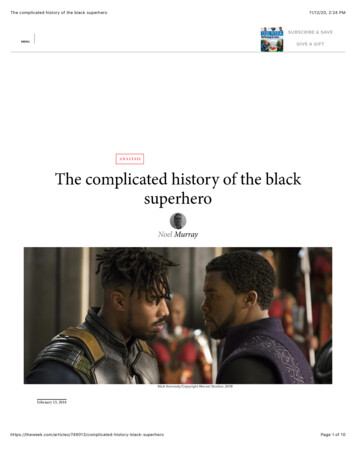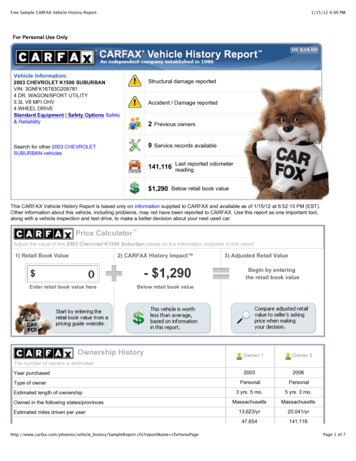
Transcription
The complicated history of the black superhero11/12/20, 2:24 PMSUBSCRIBE & SAVEMENUGIVE A GIFTSPONSOREDVanguard Advice to Help Maximize YourIncome in RetirementRead MoreA NA LY S I SThe complicated history of the blacksuperheroNoel MurrayMatt Kennedy/Copyright Marvel Studios 2018February 15, d-history-black-superheroPage 1 of 10
The complicated history of the black superheroI11/12/20, 2:24 PMt's been a long journey to get to this particular moment in popularculture. Black Panther — the much-anticipated adaptation of one ofMarvel Comics' most culturally significant superheroes — debutsthis weekend on the big screen, a month after The CW started airing BlackLightning, a thrilling and original TV series drawn from DC Comics'belated attempt to compete with Marvel.Both Black Panther and Black Lightning have often been underserved bytheir publishers. They were introduced in 1966 and 1977, respectively, inpart to address superherodom's shameful racial imbalance, with thecharacters' creative potential almost an afterthought. But over the decades,passionate writers and artists — including Black Panther writer-directorRyan Coogler and Black Lightning showrunner Salim Akil — havecommitted themselves to fleshing these heroes out, by aiming first andforemost to tell compelling stories about them, from a black perspective.But this trip was long, arduous, and complicated by the mixed motivationsthat comic book creators have had for inventing black heroes.ADVERTISEMENTThe Ebony eraLike the rest of the American mass media, the comics pages once tendedtoward broad racial stereotypes, even when artists meant well. Innovativecartoonist Will Eisner, for example — who helped pioneer the concept ofthe graphic novel in the '70s and '80s — had to answer throughout hiscareer for the big-eyed, big-lipped comic sidekick Ebony White thatappeared in his newspaper comic The Spirit throughout the 1940s.Eisner's later work railed against bigotry of all kinds, and he eventually -history-black-superheroPage 2 of 10
The complicated history of the black superhero11/12/20, 2:24 PMdrop Ebony from The Spirit, without explanation. In later iterations of thecomic written and drawn by other artists — including a DC Comics seriesthat launched in 2007 — Ebony either didn't appear at all, or was usedpointedly as a rebuke to Eisner's original version.Nevertheless, this whole dilemma exemplifies the complicationssurrounding what we do with the black comics characters of the distantpast. As painfully embarrassing as he is now, Ebony was intended by Eisnerto be a lovable, heroic assistant to the Spirit. Without his face — and thefaces of characters like him in other newspaper strips and comic books —the medium's history looks even whiter than it already is.The Panther ageIn the decade after Ebony was quietly retired, a few black comic bookheroes of note appeared, including the African chieftain Waku in theshort-lived '50s series Jungle Tales, and the western gunfighter Lobo, whostarred in two Dell Comics one-offs in 1965 and '66. But when Wakandanking T'Challa — a.k.a "Black Panther" — made his first appearance inFantastic Four, he arrived at the right time in American culture to becomea minor sensation.Though the comics featuring Black Panther weren't huge sellers in the '60sand '70s, the character himself was instantly iconic, with his nobility andrich African mythology appealing to the burgeoning Black Powermovement. More importantly, the way that writer Stan Lee and artist JackKirby approached Black Panther — as a well-rounded hero, rather than acuriosity — set a tone that carried through the way Marvel Comics wouldhandle the wave of black characters that would follow over the course ofthe next decade.Black Panther himself remained largely underused by Marvel in the '70s,but the publisher did find room in its comics for Luke "Power Man" Cage,Misty Knight, Bill "Black Goliath" Foster, Ororo "Storm" Munroe, Sam"Falcon" Wilson, Luther "Deathlok" Manning, Eric "Blade" Brooks, andJames Rhodes. These characters had diverse backgrounds, purposes, andpowers, and have endured largely because they were introduced as integralto the larger Marvel Universe — rather than being mere s/749013/complicated-history-black-superheroPage 3 of 10
The complicated history of the black superhero11/12/20, 2:24 PMDC gets wokeDC Comics, on the other hand, scrambled to play catch-up with Marvelthroughout the '60s . and well into the '70s. Stan Lee's company became afavorite of college kids and with the mainstream media, thanks to itsrelatively complex characters and engagement with real-worldsociopolitical issues. DC, though, remained stubbornly old-fashioned untillate in the '60s, when younger writers and artists like Dennis O'Neil andNeal Adams were given more freedom to modernize.In 1971, during O'Neil and Adams' groundbreaking run on Green Lantern,they introduced the character John Stewart, a backup Green Lantern whostruggled initially to earn the main hero's trust. The first cover featuringStewart portrayed him as a defiantly angry black man "who really means itwhen he warns . 'Beware my power!'"This early version of John Stewart exemplified the way that DC's blackheroes were depicted in the years that followed. One of the most famousimages of Black Lightning is of him on the cover of Justice League ofAmerica #173, shouting that he'll never join "that jive bunch of turkeys inthe JLA." In Teen Titans in the early '70s, the character Mal Duncan spentmuch of his time with the team feeling insecure and unwanted. In Superboyin 1976, the Legion of Super-Heroes met Tyroc, defender of an island ofdark-skinned people that wanted nothing to do with other races.To be fair, these characters were often more complex than they seemed onthe surface. Black Lightning, for one, wore his stand-offishness as part ofhis persona, to cover for his secret identity as mild-mannered educatorJefferson Pierce.Still, unlike the richness of Marvel's cast of black heroes, DC's early ated-history-black-superheroPage 4 of 10
The complicated history of the black superhero11/12/20, 2:24 PMat increasing racial diversity came across as more gimmicky. That wouldchange in a big way in the '80s.The Great MainstreamingThe superhero comics business suffered a sales crunch in the late '70s, butboomed again in the '80s, due to a few different factors: more maturesubject matter and storytelling; the rise of the dedicated comic book store;and a surging collectors' market, hungry for special events and reboots. Aspike in demand led to a flood of new titles and new characters.In the middle of this resurgence, DC stumbled upon the black superherowho would eventually (and somewhat unexpectedly) join the company'stop-tier pantheon. While reviving the sidekick super-group Teen Titans forthe new ongoing series The New Teen Titans, the creative team of writerMarv Wolfman and artist George Pérez followed the example of Marvel'supgraded '70s X-Men comics, which had become a runaway hit in part bydiversifying its cast. One of the new heroes Wolfman and Pérez introducedwas Victor Stone, a former college athlete who'd been in a horrific accidentat his scientist parents' lab, and had much of his body replaced by robotics.By virtue of being a key part of some of the '80s most popular comics, thischaracter, "Cyborg," stuck around even after The New Teen Titans ran itscourse. In DC's Justice League animation and movie properties — as wellas Cartoon Network's Wolfman/Pérez-inspired Teen Titans cartoons — VicStone has become a regular presence, almost as commonplace as the DCtrinity of Superman, Batman, and Wonder Woman.Cynics might suggest that DC defaults to Cyborg in movies and on TV justso that their big Justice League properties feature have at least one hero ofcolor. Even if so, it's telling that the hero they've settled on is Stone, and notJohn Stewart or Jefferson Pierce, who were introduced in the '70s withmuch more fanfare. Wolfman and Pérez kept Cyborg's racial identityintegral to his character, but like the best of Marvel's first wave of blackheroes — like Storm, or Luke Cage — he's always been a character first anda symbol second.Rewriting historyThe integration of superhero comics continued apace in the '90s and '00s,with intriguing new wrinkles. DC and Marvel shook up tradition by givingblack characters a chance to put on the costumes of the publishers' d-history-black-superheroPage 5 of 10
The complicated history of the black superhero11/12/20, 2:24 PMknown heroes. A much less testy John Stewart spent more time as GreenLantern. James Rhodes became such an important part of Iron Man'sadventures that he's now a staple of the Marvel Cinematic Universe. WhenDC "killed" Superman as part of a big '90s publicity stunt, one of thereplacements they introduced was the armored science genius John HenryIrons, codenamed "Steel."Up and down the DC and Marvel rosters, new heroes adopted familiarnames — Angel, Aqualad, Batwing, Captain America, Firestorm, GreenArrow, Hawkgirl, Mister Terrific — but with a different racial makeupfrom the characters they succeeded.The other crucial change was that more black creators were tapped to tellthese stories. The late Dwayne McDuffie co-developed Static, and laterhelped bring him to animated life in the TV cartoon Static Shock. ArtistDenys Cowan (who also co-created Static) drew comics starring Steel,Power Man, and Deathlok. Christopher Priest penned one of the greatestall-time runs of Black Panther comics in the '90s, expanding thatcharacters' universe and personality in ways that have directly influencedthe new Marvel movie.MultimediaDuring the run-up to the release of Black Panther, some over-excited popculture commentators have bought into the hype that this movie is the"first" to be anchored by a black superhero. This news would undoubtedlyflummox Wesley Snipes (star of 1998's Blade, 2002's Blade II, and 2004'sBlade: Trinity), Shaquille O'Neal (star of 1997's Steel), and Michael JaiWhite (star of 1997's Spawn . the great forgotten superhero and superheromovie of the '90s).That said, it matters a great deal that both Black Panther and BlackLightning are reclaiming characters who at one point in time helped define"the black superhero."The CW's DC-derived action-adventure shows have done marvelously wellat using color-blind and gender-blind casting so extensively that they'veeffectively reshaped decades-old mythologies into the more inclusiveuniverse they should've always been. But Black Lightning's somethingdifferent. Salim Akil and his partner Mara Brock Akil have embraced whatoriginally set Jefferson Pierce apart, and are making a show about a herofighting drug-lords, gangs, and anyone else exploiting or demeaning -history-black-superheroPage 6 of 10
The complicated history of the black superhero11/12/20, 2:24 PMpeople in his neighborhood. From it's eclectic R&B soundtrack to itsknowing nods to '70s blaxploitation movies, Black Lighting has a distinctiveflavor.As for Black Panther, it's already been pegged to be one of 2018's biggesthits, which would cement Creed writer-director Ryan Coogler as one ofHollywood's brightest young talents. And notably, rather than surroundT'Challa with white characters, Coogler's cast is mostly black, telling asprawling, globe-spanning story that acknowledges diversity even within aracial identity.Ultimately, Black Panther and Black Lightning are doing what the bestlegacy pop culture products do: honoring what their original creatorsintended, and not feeling limited by what was actually produced. In everyold and new meaning of the word, these characters have never been soseen.Try 6 Risk-Free issues of The d-history-black-superheroPage 7 of 10
The complicated history of the black superhero11/12/20, 2:24 PMSPONSORED FINANCIAL CONTENTHow to ProtectYourRetirementfrom DollarFallingAmerican HartfordGoldUS 50,000Overseas Property AlertThe rTradeSmithCan yourportfoliooutperform thebillionaires?The sciencesays yes.They built abetter stockexchange, nowIEX has apodcast0% interest for14 months. Noannual fee.10 Lessons toTake FromMillionairesWho Are ReallyGood WithMoneyIEX ExchangeThe AscentCannabis CouldBe Worth MoreThan Tesla Here’s How toInvestGet up to 5,000* commissionfree equities &options tradesThe Motley FoolTradeStation10 Tips forDeciding Whereto Live inRetirement10 Credit CardsYou Should NotIgnore If YouHave ExcellentCreditFisher InvestmentsThe Penny HoarderWhat'sChanging withPlan F vs. G vs.N - Find OutFrom OurExpertMedicareSupplement.comWall StreetQuietly PredictsMassive MarketEvent in 2021StansberryResearchNerdWalletMore from Noel MurrayMost popularAround the webSEE ALLSEE ALLPOWERED BY DIANOMISundancereckons with thestreamingrevolution1Noel MurrayTrump isreportedly 'veryaware' he lostthe election butis putting up afight as 'theater'Brendan MorrowThe refreshingawfulness ofRick and Morty2Under-theRadarCompany7 RookieMistakes toAvoid WithYou'll regretnot securingthis cash backTrump's willingaccomplicesRyan CooperNoel MurrayKnives Out d-history-black-superhero7 scathinglyPage 8 of 10
The complicated history of the black superheroKnives Out doeswhat so many ofthe bestmysteries do:Carve up therich11/12/20, 2:24 PM37 scathinglyfunny cartoonsabout Trump'srefusal toconcedeThe Week StaffNoel MurraySPONSORED BYCONNATIXThis Day in HistoryIs Going Low-Carb Right for You?Sponsored by BULLETPROOF Easy to start, and easy to integrate into your lifestyle. acy policySubscriber loginTerms & conditionsGive a giftThe Week UKPage 9 of 10
The complicated history of the black superhero11/12/20, 2:24 PMClassroom subscriptionsCustomer serviceNewslettersContact usRSSAccessibilityDo not sell my informationAd info 2020 The Week Publications Inc., All rights reserved.Subscribe and d-history-black-superheroPage 10 of 10
The superhero comics business suffered a sales crunch in the late '70s, but boomed again in the '80s, due to a few different factors: more mature . Batman, and Wonder Woman. Cynics might suggest that DC defaults to Cyborg in movies and on TV just so that their big Justice League propertie











